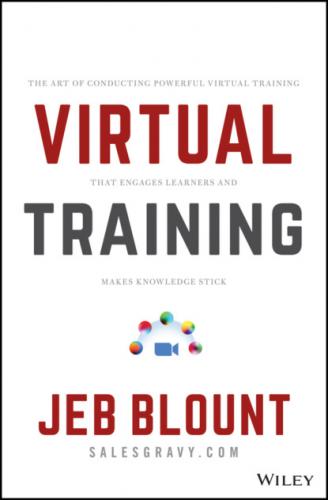People wish to communicate, collaborate, and at times commiserate as they stretch through the process of shifting their mindset and acquiring new skills. Humans long for social engagement and the shared community and experience of a classroom cohort.
Simply put, e-learning is missing that social component, so by itself it is not an effective way to develop competency and drive behavior change.
This is exactly why synchronous classroom-based and virtual instructor-led training is, and will continue to be, an important cornerstone of learning and development initiatives.
Enter Virtual Instructor-Led Training
Virtual instructor-led training (VILT) blends the social learning benefits of classroom-based training with the speed, agility, and cost-effectiveness of e-learning—without the wasted expenses associated with the physical classroom.
This means that organizations are able to deliver more high-quality training and rapidly upskill more people, at a much lower cost, which generates a far higher return on the training investment.
The good news is, for a large swath of curricula, VILT, delivered well, is just as effective as classroom training. Furthermore, because a virtual training curriculum can be chunked into shorter training sessions, it is often superior to classroom training when it comes to making learning stick. Numerous academic studies have proven that humans can better retain and apply learned skills when training is delivered in succinct, easy-to-consume chunks.
Richard E. Mayer's segmenting principle describes how chunking breaks complex curricula and courses into concise virtual sessions.4 For example, eight hours of physical classroom training might be broken into smaller segments (e.g., eight 1-hour sessions, four 2-hour sessions) with time between each session for practice, homework assignments, and blended e-learning content.
Rather than the firehose-in-the-mouth format that physical classroom training typically requires, VILT redesigns the learning path to work the way humans learn best—in short, sequential chunks of information that layer one lesson upon another and present opportunities for repetition and practice.
Learning outcomes improve further when there is time between these chunks of training for participants to practice new skills in the real world, with supportive instructor coaching. These breaks between training sessions provide a faster feedback loop that accelerates the cognitive process of learning. However, this form of on-the-job experiential learning—learning by doing—is impractical with most classroom-based training (see cost and travel constraints).
Compared with traditional classroom training, the combination of chunking and experiential learning in a VILT environment is often a better investment for organizations. When used together, these two strategies improve the probability that training will stick and the desired behavioral changes will be actualized.
While it is certainly more challenging to re-create the social and collaborative environment of the physical classroom in a virtual setting, VILT more than makes up for this shortcoming in other important ways:
Agility and flexibility. Virtual training may be delivered in almost any configuration over any duration.
Low risk and rapid iteration. It is easier to experiment and pilot virtual training initiatives because the risk and cost of failure is low. Likewise, virtual training may be deployed quickly and continuously improved with little risk to the organization or negative impact on the learners.
No walls and few limits. Learners may access virtual training sessions from almost anywhere. All they need is an internet connection and a connected device.
Session review. Virtual sessions may be recorded and made available for learners to review in the LMS. If a participant misses a session or needs a quick refresher, it is easy to catch up and stay on track.
Enhanced and extended communication. Interactive breakout groups and discussion boards make it easy for participants and instructors to collaborate, get feedback, and communicate both inside and outside of the classroom.
Structure and freedom. VILT provides both the structured, social learning environment that humans require for true behavioral change and freedom from the confines of the physical classroom.
The virtual training structure—a combination of scheduled live training sessions, in-classroom activities and breakout sessions, homework assignments, self-paced learning, and accountability—makes it far superior to e-learning and most classroom-based training.
One more fringe benefit of VILTs: they're green. Most modern organizations are focused on reducing their overall carbon footprint. Similarly, many employees are concerned about climate change and sustainability.
According to an Open University study, virtual training consumes about 87 percent less energy and produces 85 percent fewer CO2 emissions than classroom-based training.5 One more reason to love virtual training.
Notes
1 1 Christopher Pappas, “Top 20 eLearning Statistics for 2019 You Need to Know,” eLearning Industry.com, September 24, 2019, https://elearningindustry.com/top-elearning-statistics-2019.
2 2 Justin Reich and José A. Ruipérez-Valiente, “The MOOC Pivot,” Science, January 11, 2019, https://science.sciencemag.org/content/363/6423/130.
3 3 The Editors of Encyclopaedia Britannica, “Social Learning,” Encyclopaedia Britannica, September 13, 2019, https://www.britannica.com/science/social-learning.
4 4 Richard E. Mayer, Multimedia Learning (Cambridge University Press, 2009), 175–188.
5 5 Sally Caird and Robin Roy, “Sustainable Higher Education Systems,” in Encyclopaedia of Sustainability and Higher Education, ed. Walter Leal Filho (Springer Nature: 2019), https://doi.org/10.1007/978-3-319-63951-2_261-1.
4 Experience Is Everything
As our virtual training business exploded, many of my peers in our industry segment called to ask (and learn) about how we’d so quickly pivoted from in-classroom training to virtual. After I shared my story about building our virtual training studios, the responses that followed were typically along the lines of:
“Wow, you are way ahead of the curve.”
“Your timing was impeccable.”
“You are so far ahead of everyone else.”
“You really got lucky.”
I heard “You got lucky” a lot. Even from my own family. Trust me, in the moment, with so many other training companies taking it on the chin because they were not able to switch to virtual, I felt lucky.
But it wasn't luck.
